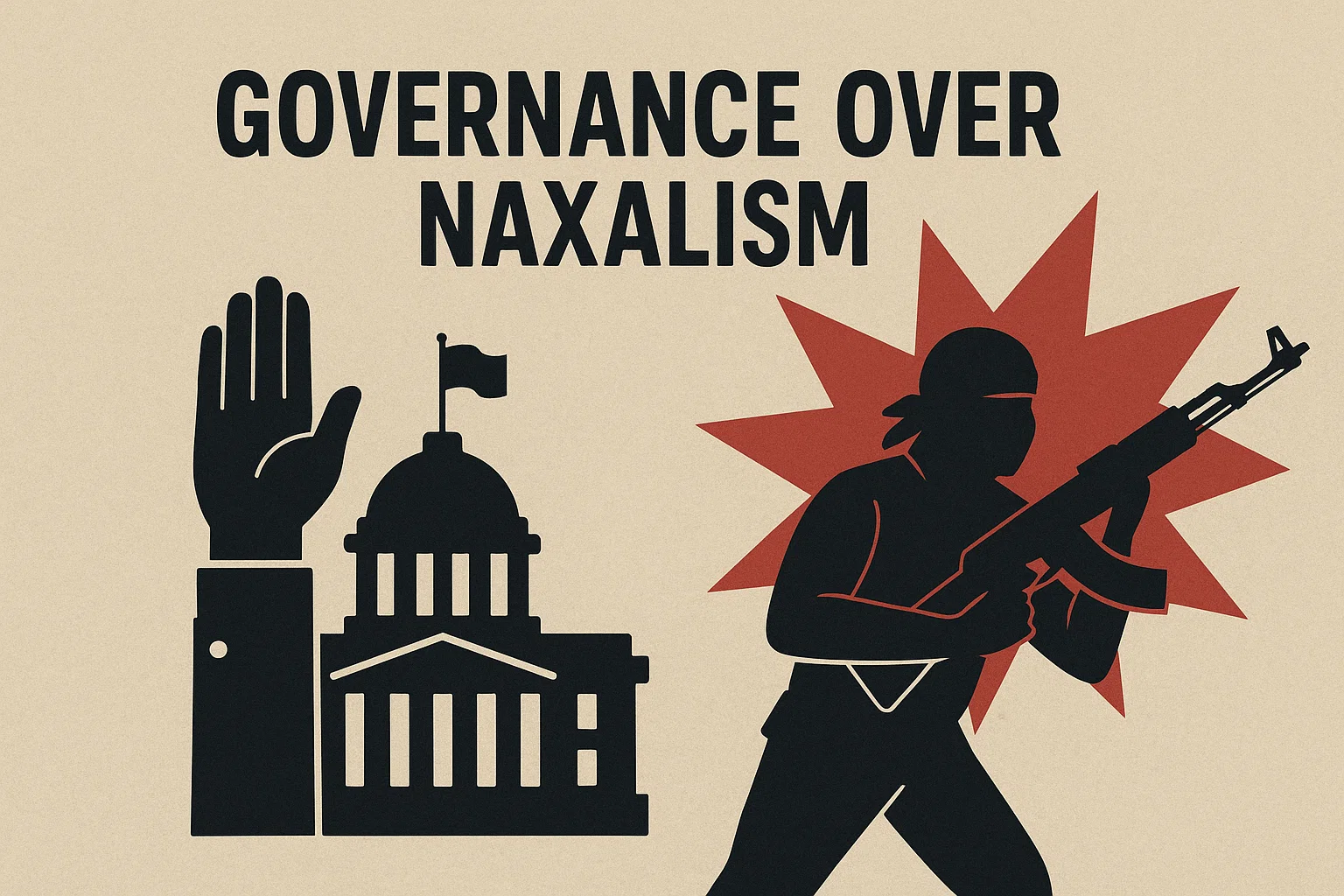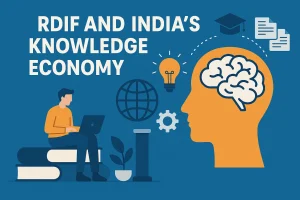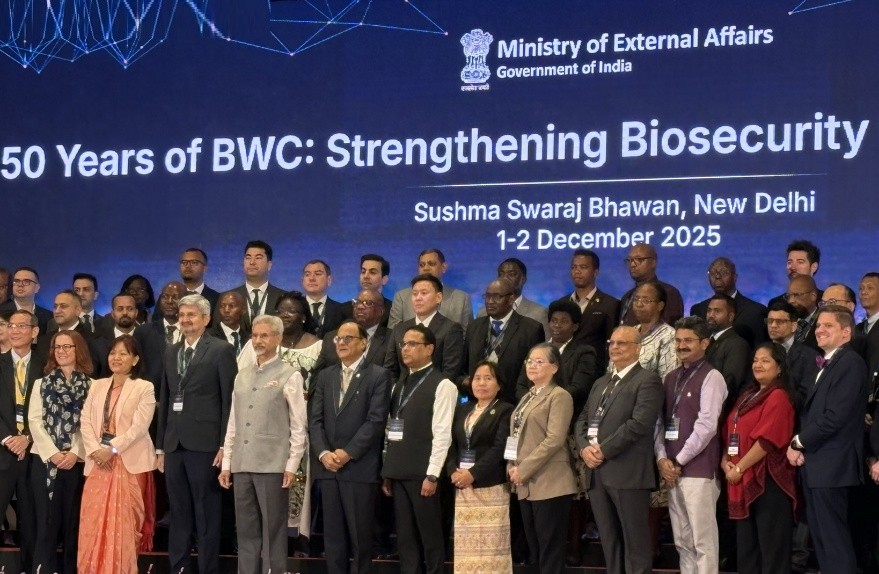Governance over Naxalism
Explore how strong governance, justice, and accountability—not poverty eradication alone—are transforming India’s fight against Left-Wing Extremism. Based on Shamika Ravi and Manuj Joshi’s “Red Corridor to Green Shoots”, this analysis explains how inclusive policies, trust-building, and moral leadership can turn Naxal-affected regions into models of peace and development.
From Red Corridor to Green Shoots
India’s progress is often measured not only by its economy but also by its ability to overcome internal conflict. One of the longest-running challenges has been Left-Wing Extremism (LWE), commonly known as the Naxalite movement. This movement, once spread across large parts of India, questioned the fairness of governance and the inclusiveness of growth. In their essay titled “Red Corridor to Green Shoots” (The Indian Express, 3 November 2025), Shamika Ravi and Manuj Joshi argue that the problem of extremism is not simply one of poverty or inequality—it is, at its heart, a challenge of governance. They believe that the trust people place in the fairness and justice of the state is what ultimately defeats extremism, not economic aid or military strength alone.

Poverty Narrative Revisited
For many years, people believed that Naxalism was caused by poverty. Policymakers assumed that improving roads, jobs, and industries would make the problem disappear. Ravi and Joshi challenge this belief using logic and evidence. They ask why, if Naxalites truly fought for the poor, they often destroyed schools, railways, and mobile towers—things that help the poor. Their answer is that the movement’s survival depends on keeping people isolated and mistrustful of the government, not on lifting them out of hardship.
They also refer to studies from India and abroad. Research by the National Bureau of Economic Research and the University of North Carolina shows that ideology and weak governance, rather than low income, are better predictors of violence. Indian studies published in Economic and Political Weekly point out that Maoist activity is highest in forest areas, where the state’s presence is weakest. Poverty itself does not create violence; rather, the absence of fair governance allows it to thrive.
Governance as the Central Challenge
The authors claim that ending Left-Wing Extremism is mainly a matter of governance. When people see the state as visible, accountable, and fair, extremist ideas lose their hold. The Indian government’s newer approach reflects this understanding. It now combines military operations with social development—building schools, skill centres, and roads along with restoring law and order.
The results are encouraging. Civilian deaths have fallen sharply, the number of affected districts has dropped from over a hundred to fewer than twenty, and attacks on economic targets have declined. These facts show that better governance weakens extremism. Yet, as Ravi and Joshi warn, the battle is not over. Many regions still face weak institutions, corruption, and local grievances. The road from “red” to “green” corridors is long and demands constant attention.
Understanding Good Governance
While Ravi and Joshi clearly identify governance as the solution, they leave its meaning somewhat broad. Good governance is not just about building infrastructure; it also includes honesty, fairness, and accessibility in daily life. A good road or school is meaningless if teachers are absent or if the police are unfair. True governance must be humane as well as efficient.
In areas once neglected or exploited by officials, people will not automatically trust the returning state. Trust must be rebuilt through consistent service, transparency, and fairness. Governance, therefore, is not simply a matter of administration but of moral responsibility—the state must prove that it deserves the people’s confidence.
Moral and Civilisational Dimensions
The discussion gains depth by linking India’s governance challenge to its moral and civilisational ideals. India’s heritage has long upheld peace, compassion, and dialogue. The authors contrast this moral tradition with the violent ideology of the Naxalites, revealing the sharp contradiction between the country’s enduring values and the destructive methods of extremism. However, the discussion must also admit that the Indian state has sometimes used excessive force. True victory will come not only from military control but from winning hearts. The government’s return to these regions must be marked by empathy and justice. When citizens see that the state protects them, listens to them, and provides for them fairly, the appeal of violence fades naturally.
Policy Shift and Its Promise
The discussion highlights the government’s goal of a “Naxal-Mukt Bharat”—an India free from Left-Wing Extremism. This vision is pursued through a mix of security efforts and developmental programmes such as Eklavya Model Residential Schools, Skill Development Centres, and improved road and digital connectivity. These initiatives provide people with alternatives to violence and help restore their sense of inclusion and belonging.
This cooperative approach, where the Centre and States work together, has proven more effective than past isolated efforts. It reflects an understanding that the fight against extremism is both moral and administrative. Yet, progress must be maintained. The “green shoots” of peace can survive only if institutions continue to uphold justice, equality, and opportunity. Without constant reform, the old cycle of neglect and distrust could return.
Critique and Caution
Although Ravi and Joshi’s argument is convincing, it risks simplifying a complex issue. Replacing the “poverty” explanation with a “governance” one is helpful, but it should not ignore the deep-rooted injustices that gave rise to rebellion in the first place. In many regions, people suffered exploitation by corrupt officials, forest officers, or landlords. True governance must include restorative justice—acknowledging past wrongs and ensuring inclusion.
Calling Naxalism entirely “parasitic” also oversimplifies reality. While the movement’s leaders may have turned exploitative, its early supporters were driven by genuine grievances. Preventing resurgence requires addressing those grievances, not just providing roads or schools. Effective governance must therefore be empathetic, listening to local voices and protecting cultural identities. Peace built on fairness lasts longer than peace enforced through power.
Conclusion
The article “Red Corridor to Green Shoots” offers a thoughtful and hopeful view of India’s long struggle with extremism. It reframes the problem not as a fight against the poor but as a test of the state’s capacity for justice and trust. The essay’s greatest strength lies in showing that peace cannot be achieved by force or charity alone; it must be earned through good governance.
As India aspires to greater global stature, internal peace and fairness are as vital as economic success. True progress will come when citizens feel heard, respected, and protected. The “green shoots” mentioned by Ravi and Joshi represent more than development—they symbolise renewed faith in democracy and the rule of law.
To defeat extremism is to build a state that people can trust. The ultimate victory lies not in military success but in moral renewal—the transformation of power into trust. When governance is fair, transparent, and humane, India’s red corridors will indeed turn green, and peace will take deep root in its soil.
Subscribe to our Youtube Channel for more Valuable Content – TheStudyias
Download the App to Subscribe to our Courses – Thestudyias
The Source’s Authority and Ownership of the Article is Claimed By THE STUDY IAS BY MANIKANT SINGH





